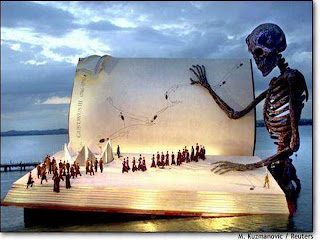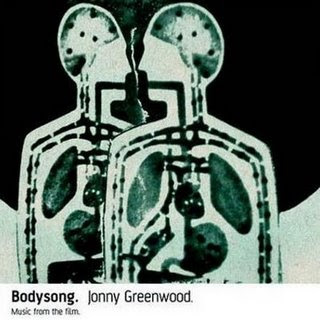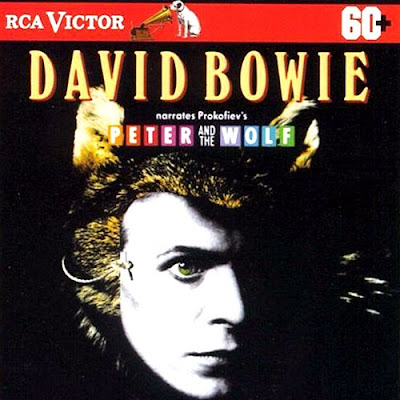
jueves, 31 de diciembre de 2009
miércoles, 30 de diciembre de 2009
lunes, 28 de diciembre de 2009
ap.
Miles Davis - Bitches Brew: Album Original de 1970 y Sesiones (4 Discos)


Wikipedia: Bitches Brew Is a studio double album by jazz musician Miles Davis, released in April 1970 on Columbia Records. The album continued Davis' experimentation of electric instruments previously featured on his critically acclaimed In a Silent Way album. With the use of these instruments, such as the electric piano and guitar, Davis rejected traditional jazz rhythms in favor of a looser, rock-influenced improvisationalstyle.One of Davis' best-selling albums and masterpieces, Bitches Brew marked a turning point in modern jazz. Upon release, it received a mixed response, due to the album's unconventional style and revolutionary sound.Recording sessions took place at Columbia's 30th Street Studio over the course of three days in August 1969. Davis called the musicians to the recording studio on very short notice. A few pieces on Bitches Brew were rehearsed before the recording sessions, but at other times the musicians had little or no idea what they were to record. Once in the recording studio, the players were typically given only a few instructions: atempo count, a few chords or a hint of melody, and suggestions as to mood or tone. Davis liked to work this way; he thought it forced musicians to pay close attention to one another, to their own performances, or to Davis's cues, which could change at any moment. On the quieter moments of "Bitches Brew", for example, Davis's voice is audible, giving instructions to the musicians: snapping his fingers to indicate tempo, or, in his distinctive whisper, saying, "Keep it tight" or telling individuals when to solo.
Davis composed most of the music on the album. The two important exceptions were the complex "Pharaoh's Dance" (composed by Joe Zawinul) and the ballad "Sanctuary" (composed by Wayne Shorter). The latter had been recorded as a fairly straightforward ballad early in 1968, but was given a radically different interpretation on Bitches Brew. It begins with Davis and Chick Corea improvising on the standard "I Fall in Love too Easily" before Davis plays the "Sanctuary" theme. Then, not unlike Davis's recording of Shorter's "Nefertiti" two years earlier, the horns repeat the melody over and over while the rhythm section builds up the intensity. The issued "Sanctuary" is actually two consecutive takes of the piece.
Despite his reputation as a "cool", melodic improviser, much of Davis's playing on this album is aggressive and explosive, often playing fast runs and venturing into the upper register of the trumpet. His closing solo on "Miles Runs the Voodoo Down" is particularly noteworthy in this regard. Davis did not perform on the short piece "John McLaughlin".
There was significant editing done to the recorded music. Short sections were spliced together to create longer pieces, and various effects were applied to the recordings. One source worth quoting at length reports:Bitches Brew also pioneered the application of the studio as a musical instrument, featuring stacks of edits and studio effects that were an integral part of the music. Miles and his producer,Teo Macero, used the recording studio in radical new ways, especially in the title track and the opening track, "Pharaoh's Dance". There were many special effects, like tape loops, tape delays,reverb chambers and echo effects. Through intensive tape editing, Macero concocted many totally new musical structures that were later imitated by the band in live concerts. Macero, who has aclassical education and was most likely inspired by the 1930s and 1940s musique concrète experiments, used tape editing as a form of arranging and composition.
"Pharaoh's Dance" contains 19 edits – its famous stop-start opening is entirely constructed in the studio, using repeat loops of certain sections. Later on in the track there are several micro-edits: for example, a one-second-long fragment that first appears at 8:39 is repeated five times between 8:54 and 8:59. The title track contains 15 edits, again with several short tape loops of, in this case, five seconds (at 3:01, 3:07 and 3:12). Therefore, Bitches Brew not only became a controversial classic of musical innovation, it also became renowned for its pioneering use of studio technology.
Though Bitches Brew was in many ways revolutionary, perhaps its most important innovation was rhythmic. The rhythm section for this recording consists of two bassists (one playing bass guitar, the other double bass), two to three drummers, two to three electric piano players, and a percussionist, all playing at the same time. As Paul Tanner, Maurice Gerow, and David Megill explain, "like rock groups, Davis gives the rhythm section a central role in the ensemble's activities. His use of such a large rhythm section offers the soloists wide but active expanses for their solos."
Tanner, Gerow and Megill further explain that
"the harmonies used in this recording move very slowly and function modally rather than in a more tonal fashion typical of mainstream jazz.... The static harmonies and rhythm section's collective embellishment create a very open arena for improvisation. The musical result flows from basic rock patterns to hard bop textures, and at times, even passages that are more characteristic of free jazz."
The solo voices heard most prominently on this album are the trumpet and the soprano saxophone, respectively of Miles and Wayne Shorter. Notable also is Bennie Maupin's ghostly bass clarinet, which was perhaps the first use of the instrument in jazz not heavily indebted to pioneer Eric Dolphy.
The technology of recording, analog tape, disc mastering and inherent recording time constraints (i.e., bandwidth) had, by the late sixties, expanded beyond previous limitations and sonic range for the stereo, vinyl album: Bitches Brew reflects this. In it are found long-form performances which encompass entire improvised suites with rubato sections, tempo changes or the long, slow crescendo more common to a symphonic orchestral piece or Indian raga form than the three-minute rock song. Starting in 1969, Davis' concerts included some of the material that would become Bitches Brew.
Bitches Brew was a turning point in modern jazz. Davis had already spearheaded two major jazz movements – cool and modal jazz – and was about to initiate another major change (the album's cover also sports the phrase "Directions In Music By Miles Davis" above the title.
Some critics at the time characterized this music as simply obscure and "outside", which recalls Duke Ellington's description of Davis as "the Picasso of jazz." Some jazz fans and musicians felt the album was crossing the limits, or was not jazz at all. One critic writes that "Davis drew a line in the sand that some jazz fans have never crossed, or even forgiven Davis for drawing." Bob Rusch recalls, "this to me was not great Black music, but I cynically saw it as part and parcel of the commercial crap that was beginning to choke and bastardize the catalogs of such dependable companies as Blue Note and Prestige.... I hear it 'better' today because there is now so much music that is worse."
On the other hand, many fans, critics, and musicians see the records as an important, vital release. In a 1997 interview, drummer Bobby Previte sums up his feelings about Bitches Brew: "Well, it was groundbreaking, for one. How much groundbreaking music do you hear now? It was music that you had that feeling you never heard quite before. It came from another place. How much music do you hear now like that?" The Penguin Guide to Jazz gaveBitches Brew a four-star rating (out of four stars), describing the recording as "one of the most remarkable creative statements of the last half-century, in any artistic form. It is also profoundly flawed, a gigantic torso of burstingly noisy music that absolutely refuses to resolve itself under any recognized guise." In 2003, the album was ranked number 94 on Rolling Stone magazine's list of the 500 greatest albums of all time. Along with this accolade, the album has been ranked at or near the top of several other magazines' "best albums" lists in disparate genres.
Bitches Brew is often called the best-selling jazz record. Such sales figures have been disputed, but it was Davis's first gold record, selling more than half a million copies. Kind of Blue, another groundbreaking record released eleven years prior to Bitches Brew's release, has also been cited as perhaps the best-selling jazz release. In 1998, Columbia Records released The Complete Bitches Brew Sessions, a four-disc box set that included the original album as well as the studio sessions through February 1970.
Corre

ooooooooooooooo corre. cruza el alambrado. ve más despacio. te atacarían los perros, si no es que hay hienas. tras los pinos de allá está el camino a la montaña. espera. ahora, ve hacia la montaña pero tampoco ahí encuentres refugio x a más de las doce empieza a llenarse la luna, empieza igualmente el frío, ¿cuánto hará que huyes sin ver que en la sombra está la luz que buscas, no encuentras y te busca? nnn no tendrás más sed pero no habrás bebido. volverán ser las 12 k seguirás corriendo. se llenará una y otra vez la luna. será calor, después el frío.
domingo, 27 de diciembre de 2009
Fotografías de Juan Rulfo
sábado, 26 de diciembre de 2009
Jonny Greenwood, Bodysong
.jpg)

w:Bodysong es un film-documental del director Británico Simon Pummel hecho en base a imágenes de archivo de filmotecas de todo el mundo, dichas imágenes capturan la esencia del ser humano y su desarrollo desde tiempos remotos hasta nuestros días. El documental cuenta con la música del prestigioso guitarrista de Radiohead, Jonny Greenwood, con su primer proyecto discográfico en solitario; también titulado "Bodysong".
viernes, 25 de diciembre de 2009
David Bowie narrates Prokofiev's "Peter & The Wolf".

Pedro y el lobo es una composición sinfónica de Sergei Prokofiev escrita en 1936 después de su regreso a la Unión Soviética la cual está basada en el cuento popular ruso.Sergei Prokofiev en 1936 fue encargado por el Centro de Teatro Infantil de Moscú para escribir una sinfonía musical para niños. La intención es cultivar gustos musicales en los niños desde los primeros años de la escuela. La asistencia en el debut, el 2 de mayo de 1936 fue, según el propio compositor: «pobre y no atrajo mucho la atención».
Pedro y el lobo se califica para flauta, oboe, clarinete en A, fagot, 3 cornos, trompeta, trombón, timbales, triángulo, pandereta, platillos, castañuelas, tambor de caja, bombo y cuerdas.
Cada personaje de la historia tiene un instrumento y un tema musical, o leitmotiv:
Pedro: instrumentos de cuerda
Abuelo: fagot
Pájaro: flauta
Pato: oboe
Gato: clarinete en La
El Lobo: trompa
Cazadores: viento madera
Disparos: timbales, bombo
Historia:
En un pueblo de Rusia donde todos estaban aterrorizados por un lobo del bosque vivia un niño llamado Pedro. Pedro vivia en la casa de su abuelo que queda en la tala de los bosques. Un día, Pedro sale, dejando abierta la puerta del jardín; sale un pájaro andando feliz por el lugar y acompaña a pedro. Al dejar Pedro la puerta abierta, un pato ve que hay un estanque y decide entrar a nadar, el pato entra y el pájaro le pregunta: ¿qué clase de ave eres tú que no puedes volar? - a lo que el pato replica: ¿qué clase de ave eres tú que no puedes nadar?. Sale un gato perezoso que solo estaba pendiente de querer comerse al pájaro. El pensaba y pensaba hasta que en un momento el pájaro se descuidó y lo atrapó, pero no se lo pudo comer. Hasta que El abuelo de Pedro lo vio y le dijo: "no debes estar afuera, no es seguro. ¿No sabes que hay un lobo suelto? y añadió: ¿sabes algo sobre los lobos? "Pues yo se que son muy tenebrosos" -Pedro le respondió, y le dijo que no tenia miedo, que el era un niño muy valiente y podía atrapar al lobo. Jalándolo de la oreja lo llevó a la casa y cerró la puerta. Pedro frustrado vio a través de un hueco hasta que se asustó y vio al Lobo. El gato vio al lobo y trató de montarse en un árbol para que el lobo no lo atrapara. Pedro sorprendido le dice al pato que escape del lobo, pero el pato muy tonto salió del agua, cayéndose y resbalándose, y con la lentitud que iba el lobo llegó y se lo comió. Y ahora las cosas estaban así: el gato empezó a ver que el pájaro estaba distraído, notó que estaba triste por que se comieron al pato pero al gato sólo le importaba comérselo. Mientras tanto, el Lobo lamía sus mandíbulas. Pedro intentó salir por un hueco en la cubierta de la casa con una cuerda en la mano, y una vez fuera se montó en una rama de un árbol cercano. El pájaro sabía volar, pero accidentalmente se cayó en su hocico. Sin embargo, el lobo no podía comérselo y mientras tanto Pedro preparó la cuerda y la bajó cuidadosamente para atraparle y lo logró. El lobo, con todas sus fuerzas, trató de liberarse; Pedro igualmente halaba con todas sus fuerzas temeroso de que pudiera liberarse, hasta que el lobo agotado dejó de moverse. En eso llegaron unos 3 cazadores, quienes al ver lo que pasaba levantaron sus escopetas para alejar y asustar al lobo. Se acercaban sigilosamente para no ser escuchados, hasta que vieron que Pedro había atrapado al lobo. Llevaron el lobo al pueblo, en donde todos celebraron felices por que el terror allí había terminado. De repente, el pato salió del tronco del lobo y al parecer no estaba muerto, pues el lobo se lo tragó sin morderle, de esa forma el pato vivió.
jueves, 24 de diciembre de 2009
The Beatles Christmas Album
The Beatles' Christmas Album (EE.UU.), también conocido From Then to You (RU), fue un álbum de compilación de los registros de Navidad emitidos por The Beatles y que estaban únicamente disponibles para los miembros de sus clubes de fans oficiales en el Reino Unido y Estados Unidos. The Beatles' Christmas Album se publicó como From Then to You en el Reino Unido por la discográfica Apple Records (LYN 2154) y en los EE.UU. (SBC 100).Cada año, desde 1963 hasta 1969, The Beatles grababan un breve mensaje de Navidad para sus fans, integrado por villancicos, parodias y chistes. Cada grabación era presentada sobre un disco de 7" flexi y era enviado gratis a los miembros del club de fans. En 1970, a raíz de la ruptura de la banda, Apple publicó la compilación de las siete grabaciones.
Merry Christmas Mr. Lawrence

Wiki:
Merry Christmas, Mr. Lawrence (Japanese: Senjō no Merī Kurisumasu (戦場のメリークリスマス Battlefield Merry Christmas?)), also known as Furyo in many European editions) is a 1983 film directed by Nagisa Oshima, produced by Jeremy Thomas and starring David Bowie, Tom Conti, Ryuichi Sakamoto, Yuya Uchida, and Takeshi Kitano.
It was written by Oshima and Paul Mayersberg and based on Laurens van der Post's experiences during World War II as a prisoner of war as depicted in his works The Seed and the Sower (1963) and The Night of the New Moon (1970). Sakamoto also wrote the musical score and the vocal theme "Forbidden Colours" featuring David Sylvian, which was a hit single in many territories.
The film is notable for its soundtrack, by Ryuichi Sakamoto. The main score, which bears the same title as the movie, ranks among Sakamoto's most well-known songs and made him known to a broader public. The soundtrack also contains the vocal version of this title track, better known as "Forbidden Colours" with lyrics sung and composed by David Sylvian.









